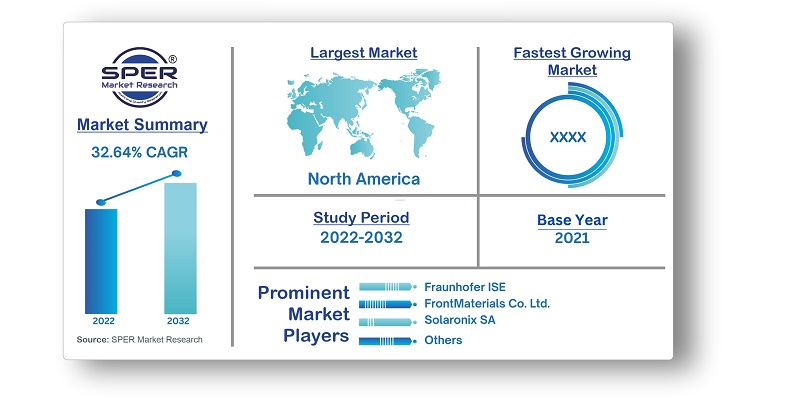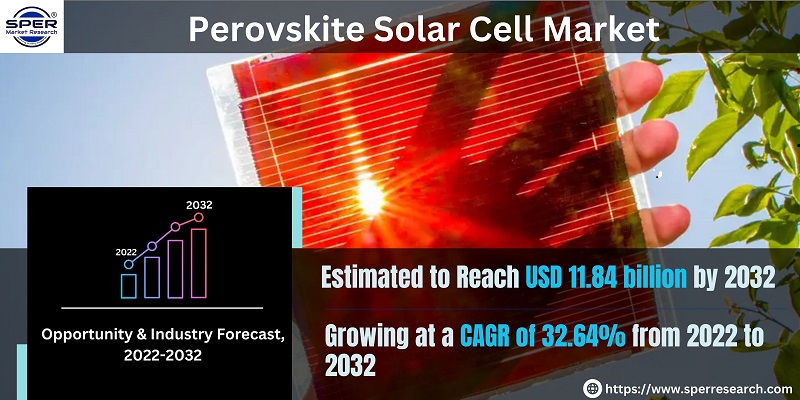
Perovskite Solar Cell Market Growth, Size, Revenue, Upcoming Trends and Future Competition 2032
Perovskite Solar Cell Market Size- By Type, By Structure, By Product, By Technology, By Application, By End User- Regional Outlook, Competitive Strategies and Segment Forecast to 2032
| Published: Jan-2023 | Report ID: POAE2302 | Pages: 1 - 241 | Formats*: |
| Category : Power & Energy | |||


| Report Metric | Details |
| Market size available for years | 2019-2032 |
| Base year considered | 2021 |
| Forecast period | 2022-2032 |
| Segments covered | By Type, By Structure, By Product, By Technology, By Application, By End User |
| Regions covered | Asia Pacific, Europe, Middle East and Africa,North America, Latin America |
| Companies Covered | Dyesol, FlexLink Systems Inc., Fraunhofer ISE, FrontMaterials Co. Ltd., New Energy Technologies Inc, Oxford Photovoltaics, Polyera Corporation, Saule Technologies, Solaronix SA, Xiamen Weihua Solar Co. Ltd. |
- Aerospace & Defense
- Commercial
- Industrial
- Residential
- Utility
- Hybrid Perovskite Solar Cell
- Multi-Junction Perovskite Solar Cell
- Mesoporous Solar Cell
- Planar Perovskite Solar Cell
- Rigid Perovskite Solar cell
- Flexible Perovskite Solar cell
- One-Step Method
- Thermal Vapor Deposition Method
- Two-Step Method
- Building-Integrated Photovoltaics
- Smart Glass
- Solar Panel
- Others
- Aerospace & Defense
- Commercial
- Industrial
- Residential
- Utility
- Asia-Pacific
- Europe
- Middle East & Africa
- North America
- Latin America
- Size of Global Perovskite Solar Cell Market (FY’2019-FY’2032)
- Overview of Global Perovskite Solar Cell Market
- Segmentation of Global Perovskite Solar Cell Market By Type (Hybrid Perovskite Solar Cell, Multi-Junction Perovskite Solar Cell)
- Segmentation of Global Veterinary Reference Laboratory Market By Structure (Mesoporous Solar Cell, Planar Perovskite Solar Cell)
- Segmentation of Global Perovskite Solar Cell Market By Product (Rigid Perovskite Solar cell, Flexible Perovskite Solar cell)
- Segmentation of Global Perovskite Solar Cell Market By Technology (One-Step Method, Thermal Vapor Deposition Method, Two-Step Method, Vapor-Assisted Solution Method)
- Segmentation of Global Perovskite Solar Cell Market By Application (Building-Integrated Photovoltaics, Smart Glass, Solar Panel, Others)
- Segmentation of Global Perovskite Solar Cell Market By End User (Aerospace & Defense, Commercial, Industrial, Residential, Utility)
- Statistical Snap of Global Perovskite Solar Cell Market
- Growth Analysis of Global Perovskite Solar Cell Market
- Problems and Challenges in Global Perovskite Solar Cell Market
- Competitive Landscape in the Global Perovskite Solar Cell Market
- Impact of COVID-19 and Demonetization on Global Perovskite Solar Cell Market
- Details on Recent Investment in Global Perovskite Solar Cell Market
- Competitive Analysis of Global Perovskite Solar Cell Market
- Major Players in the Global Perovskite Solar Cell Market
- SWOT Analysis of Global Perovskite Solar Cell Market
- Global Perovskite Solar Cell Market Future Outlook and Projections (FY’2019-FY’2032)
- Recommendations from Analyst
1.1. Scope of the report1.2. Market segment analysis
2.1 Research data source
2.1.1 Secondary data2.1.2 Primary data2.1.3 SPER’s internal database2.1.4 Premium insight from KOL’s
2.2 Market size estimation
2.2.1 Top-down and Bottom-up approach
2.3 Data triangulation
4.1. Driver, Restraint, Opportunity and Challenges analysis
4.1.1 Drivers4.1.2 Restraints4.1.3 Opportunities4.1.4 Challenges
4.2. COVID-19 Impacts of the Global Perovskite Solar Cell Market
5.1. SWOT analysis
5.1.1 Strengths5.1.2 Weaknesses5.1.3 Opportunities5.1.4 Threats
5.2. PESTEL analysis
5.2.1 Political landscape5.2.2 Economic landscape5.2.3 Social landscape5.2.4 Technological landscape5.2.5 Environmental landscape5.2.6 Legal landscape
5.3. PORTER’S five forces analysis
5.3.1 Bargaining power of suppliers5.3.2 Bargaining power of Buyers5.3.3 Threat of Substitute5.3.4 Threat of new entrant5.3.5 Competitive rivalry
5.4. Heat map analysis
6.1 Global Perovskite Solar Cell Manufacturing Base Distribution, Sales Area, Product Type6.2 Mergers & Acquisitions, Partnerships, Product Launch, and Collaboration in Global Perovskite Solar Cell Market
7.1 Hybrid Perovskite Solar Cell7.2 Multi-Junction Perovskite Solar Cell
8.1 Mesoporous Solar Cell8.2 Planar Perovskite Solar Cell
9.1 Rigid Perovskite Solar cell9.2 Flexible Perovskite Solar cell
10.1 One-Step Method10.2 Thermal Vapor Deposition Method10.3 Two-Step Method10.4 Vapor-Assisted Solution Method
11.1 Building-Integrated Photovoltaics11.2 Smart Glass11.3 Solar Panel11.4 Others
12.1 Aerospace & Defense12.2 Commercial12.3 Industrial12.4 Residential12.5 Utility
13.1 Global Perovskite Solar Cell Size and Market Share by Region (2019-2025)13.2 Global Perovskite Solar Cell Size and Market Share by Region (2026-2032)
13.3 Asia-Pacific
13.3.1 Australia13.3.2 China13.3.3 India13.3.4 Japan13.3.5 South Korea13.3.6 Rest of Asia-Pacific
13.4 Europe
13.4.1 France13.4.2 Germany13.4.3 Italy13.4.4 Spain13.4.5 United Kingdom13.4.6 Rest of Europe
13.5 Middle East & Africa
13.5.1 Kingdom of Saudi Arabia13.5.2 United Arab Emirates13.5.3 Rest of Middle East & Africa
13.6 North America
13.6.1 Canada13.6.2 Mexico13.6.3 United States
13.7 Latin America
13.7.1 Argentina13.7.2 Brazil13.7.3 Rest of Latin America
14.1 Dyesol
14.1.1 Company details14.1.2 Financial outlook14.1.3 Product summary14.1.4 Recent developments
14.2 FlexLink Systems Inc.
14.2.1 Company details14.2.2 Financial outlook14.2.3 Product summary14.2.4 Recent developments
14.3 Fraunhofer ISE
14.3.1 Company details14.3.2 Financial outlook14.3.3 Product summary14.3.4 Recent developments
14.4 FrontMaterials Co. Ltd.
14.4.1 Company details14.4.2 Financial outlook14.4.3 Product summary14.4.4 Recent developments
14.5 New Energy Technologies Inc
14.5.1 Company details14.5.2 Financial outlook14.5.3 Product summary14.5.4 Recent developments
14.6 Oxford Photovoltaics
14.6.1 Company details14.6.2 Financial outlook14.6.3 Product summary14.6.4 Recent developments
14.7 Polyera Corporation
14.7.1 Company details14.7.2 Financial outlook14.7.3 Product summary14.7.4 Recent development
14.8 Saule Technologies
14.8.1 Company details14.8.2 Financial outlook14.8.3 Product summary14.8.4 Recent developments
14.9 Solaronix SA
14.9.1 Company details14.9.2 Financial outlook14.9.3 Product summary14.9.4 Recent developments
14.10 Xiamen Weihua Solar Co. Ltd.
14.10.1 Company details14.10.2 Financial outlook14.10.3 Product summary14.10.4 Recent developments
SPER Market Research’s methodology uses great emphasis on primary research to ensure that the market intelligence insights are up to date, reliable and accurate. Primary interviews are done with players involved in each phase of a supply chain to analyze the market forecasting. The secondary research method is used to help you fully understand how the future markets and the spending patterns look likes.
The report is based on in-depth qualitative and quantitative analysis of the Product Market. The quantitative analysis involves the application of various projection and sampling techniques. The qualitative analysis involves primary interviews, surveys, and vendor briefings. The data gathered as a result of these processes are validated through experts opinion. Our research methodology entails an ideal mixture of primary and secondary initiatives.



Frequently Asked Questions About This Report
PLACE AN ORDER
Year End Discount
Sample Report
Pre-Purchase Inquiry
NEED CUSTOMIZATION?
Request CustomizationCALL OR EMAIL US
100% Secure Payment






Related Reports
Our Global Clients
Our data-driven insights have influenced the strategy of 200+ reputed companies across the globe.




















